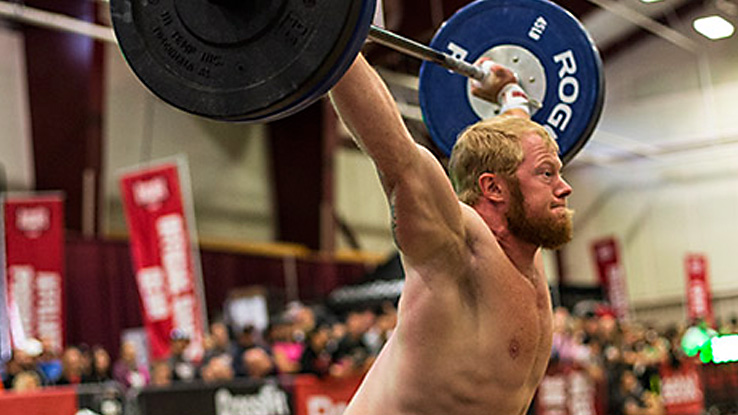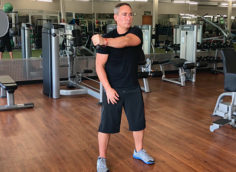Here's what you need to know...
- If your back hurts when you extend it, bend over, or twist, choose exercises that avoid those movements. These include backward sled drags, dumbbell lunges, pull throughs, hip thrusts, and Bulgarians.
- When working upper body, avoid movements that compromise the back. Your bad back won't limit your ability to do bench-pressing, chin-ups, biceps curls, or triceps pushdowns.
- Do exercises that offer back support. These include chest-supported rows, seated presses, and using a bench or floor for horizontal presses.
- Whichever movements you perform, keep the trunk neutral and stable. Don't use momentum, arch, or extra body English on any exercise.
I often work with people who tweaked their backs over the weekend and want to give it a week or two to see if it improves before making any kind of medical decision. So it's my job to keep them safely training. We can't know for certain which exercises will help alleviate back pain – it's a highly individual affliction – but we can choose safe starting points and evaluate as we go. The most common back complaints are:
- My back hurts when I extend it.
- My back hurts when I bend over.
- My back hurts when I twist.
- My back hurts doing pretty much everything.
If any of complaints 1-3 describe your situation, we can usually get around the pain by choosing exercises that avoid that movement and by being cautious in general. If complaint 4 describes your situation, but you still want to train, you can do exercises that avoid any range of motion around the spine and avoid loading it at all.
When your back limits you, continuing to meet your goals shouldn't be all that difficult. Squatting and deadlifting variations are the most stressful on the back, so those lifts and associated goals (such as vertical jump) will suffer the most. Luckily, most sports and physiques aren't made or broken on just those lifts. So we train with the following goals:
- Strengthen the glutes, hamstrings, and upper body
- Teach or improve awareness of neutral spine and core bracing
- Strengthen the core, especially the obliques
- Reduce high-impact exercises
- Increase core and back endurance
- Avoid pain as best we can
- Strengthen postural muscles
- Slowly re-introduce more stressful exercises when pain subsides
1. Backward Sled Drag
Sled drags provide a crazy quad pump and can do wonders for conditioning and leg growth, especially in those with back pain. Bonus: They're also one of the most knee-friendly exercises.
There are more cheap sleds on the market than ever, so it's hardly an excuse any more if your gym doesn't provide one. There are nylon sleds safe for gym floors and durable metal sleds costing $100 that you can drag up and down the street. A sled and some Craigslist weight plates are a worthwhile investment.
2. Dumbbell Lunge
Lunges are a great choice because they take the weight off the spine. However, it's important to remember that because the arms are connected to the upper body, spinal loading still occurs – it's not absent just because a bar isn't perched on the shoulders. So you still have to be careful and brace the core hard to keep spinal range of motion to a minimum.
3. Pull Through
Pull throughs are great because they use the anteroposterior force vector without loading the spine. When pull throughs are done properly – forcing the hamstrings to do almost all of the work without arching the back – they're a fantastically safe hamstring builder.
Note: Romanian deadlifts are great for the hip hinge and for the hamstrings, but they place too much strain on an aching back.
4. Barbell Hip Thrust

If your back is acting up, going super heavy on barbell hip thrusts isn't going to work. Heavy weight will cause you to arch your lower back as the first part of the movement, and that's when back pain shows up.
Moderately heavy weights are tolerated if good form is stressed, and that includes squeezing the glutes and hamstrings hard out towards the toes.
5. Bulgarian Split Squat
This movement is mercifully kind to the back if executed with a neutral spine.
Most upper body exercises are compatible with back pain as spinal loading and spinal range of motion aren't a big concern with upper body exercises. Chances are, your bad back won't limit your ability to do bench-pressing, chin-ups, biceps curls, or triceps push-downs. Just follow these guidelines.
- Support your chest or back when you can. If you're used to doing bent-over rows or standing overhead presses, better choices would be seated overhead presses and chest-supported rows. These won't involve the lower back nearly as much.
- Row using a cable machine. Cable rows performed in a split-stance will give more foundational support and help resist spinal flexion during a row.
- Use a bench or floor for horizontal pressing. Standing cable and band presses aren't a way to move really heavy weights – the amount of weight used is limited by the strength of the core. Use a bench or the floor instead, making sure to brace the spine against it and trying to maintain a neutral spine.
- Go unilateral. Doing unilateral (one-arm) variations of rows and presses will reduce the amount of weight used, which won't require the spinal muscles to produce as much stabilizing forces. Unilateral exercises force the body to resist trunk rotation, which may be difficult for those who have pain during twisting, but the amount of resistance used will typically determine that.
- Keep the trunk neutral and stable. Don't use momentum, arch, or extra English on any exercise. Be very strict and maintain a neutral spine and stable trunk. Cheating on biceps curls, for example, can really tweak an already flared-up back.
- Work on bracing and core strength. Besides simply coaching folks to squeeze their core hard and telling them what neutral spine looks and feels like, some exercises are instrumental in improving their feel for it. The bird dog is a great exercise for teaching core bracing and spinal awareness, as is the side plank.
- Work on posture. Slouchy upper back posture can contribute to lower back problems, so try to add more exercises that improve upper back and rotator cuff strength and endurance. Thoracic mobility work can also help open up those with forward shoulders. The "no money" exercise and pull-apart variations in the 15-20 rep range are great for building endurance.
Bird Dog
Side Plank
Pull Apart Variations & No-Money Exercise





